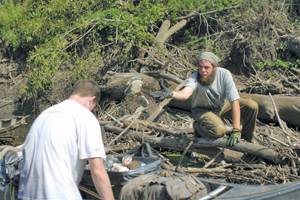Skunk River navy lightens the river’s load

Kyle Maxwell, of Ames, throws several pieces of styrofoam into a trash can on a canoe during the Skunk River Navy’s clean-up of the river on Saturday September 20, 2008 near the 16th Street bridge in Ames. Photo: Rashah McChesney/Iowa State Daily
September 21, 2008
More than 70 people showed up to volunteer to clean with the Skunk River Navy on Saturday, in a continued effort to remove the refuse from the river. An estimated 46 tons of trash has been pulled out of the Skunk River to date.
Jim Colbert, one of the driving forces behind the program, said the SRN has been cleaning up the river for 11 years.
Colbert, biology program coordinator and associate professor of ecology, evolution and organismal biology, is one of two “admirals” in the Navy. The other is Jim Holtz, academic advisor in the ecology, evolution and organismal biology .
“I do it for two reasons,” Colbert said. “I really like rivers and I really like helping other people to like rivers. I think the best way to understand that some of Iowa’s coolest natural areas are our rivers is to get people out to experience it.”
The group met at 9 a.m. in Bessey Hall, where Colbert went over some of the basics of participating in the Navy and everyone had to sign a medical history form and injury waiver.
Colbert emphasized the importance of staying with the group and not drinking the water.
“You could drink the water if you wanted to,” Colbert said. “But I wouldn’t recommend it.”
Upon arrival at the river and after unloading all of the canoes and equipment, the group was sent down to the river. They separated into six smaller groups and dispatched to hunt for organisms in the river.
Colbert armed them with an ice cube tray, a pair of tweezers and a net. Some of the larger organisms that were found, such as crawfish, were placed in larger containers, while others, such as larvae, were put into the ice cube trays.
After about 20 minutes of searching Colbert gathered everyone around to explain what each organism said about the condition of the river, then the group started off down the river.
Colbert said the day’s load of trash was probably pushing around two tons.
“It would be nice if our rivers weren’t full of tires and metal,” Colbert said. “Today was typical, lots of tires, lots of beverage containers, various other kinds of trash.”
However, despite all of the mess, both Colbert and Holtz said that over the years, the number of large objects or “trophy trash” has decreased.
“We didn’t find very big appliances today, usually we find a washing machine or a refrigerator or something of that nature,” Colbert said.
The route that the group takes is between Story City and 265th street, slightly downstream of Highway 30.
“What we try to do is hit every stretch over the river about once every three years — there’s too much to do all in one year, so we just try and do each part,” Colbert said.
Sometimes the river has a different idea of where the group should be than Colbert does.
“It sort of depends on water level and if there’s too much water, we’ll go further up into the watershed where there’s a little less, and if there’s too little water we might come down a little bit further,” he said. “We’re pretty much dependent on how much water is in the river.”
Colbert said what the group does in the river doesn’t have much impact on the water quality.
“I think we’re slowly seeing a decrease in the amount of trash, but it certainly hasn’t gotten down to zero yet,” he said.
The group is planning to start near 16th Street where it stopped Saturday and go downstream, Colbert said. However, it will depend on the water level.
“If the water level drops very much more we won’t be able to do that and we’ll have to find some other part of the river,” he said.
Holtz said that he enjoys getting outdoors and walking in the water.
“My least favorite part is at the end when we have to offload everything into the Dumpster,” he said.
The Dumpster, Colbert said, is provided by Ames Resource Recycling and Recovery, which processes the trash and then sends the weight statistics back to the group.
“Some of it can be recycled, like metal and tires, some of it can be dried and burned in Ames’ coal fired electrical plant. About 95 percent of it gets recycled and the rest goes to the landfill, but it’s better than staying in the river,” he said.
Holtz said he thinks that most students don’t have the opportunity to get out and clean up their environment.
“If they’re in the river, they’re either in a canoe or they’re not on the river and they just don’t realize the stuff that’s there. I think that just getting out and being exposed to this and seeing how much junk there is just sort of impresses upon them how much more difficult it is to take stuff out of the environment than it is to flip out of your car,” he said.






